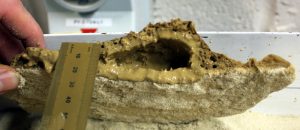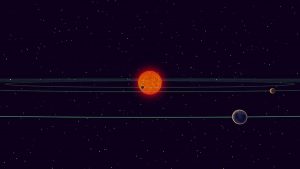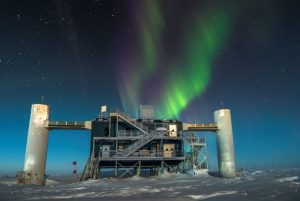Media
Transcript
Welcome to our Monday morning news bag. Not going to lie, part of my morning was spent hitting refresh ten gazillion times as I waited for some really slimy news to come out of embargo. Honestly, while there isn’t a lot of news, the news we have doesn’t disappoint.
But, I’m going to work my way toward that slime and make you wait the same way I did.
Our first story of the day is one of astronomers using gravity as a telescope; non-pointable telescopes, but telescopes nonetheless. While light has no mass, it has energy, and that good ol’ E=mc^2 means that energy and mass are the same as far as gravity is concerned. As light passes by massive objects, its path gets bent. We can see this – like you and I can test this for ourselves! – during solar eclipses, when the light from distant stars that are located near the Sun’s edge in the sky appear shifted even closer to the edge. Lenses can shift light around too, and if a lens or a mass is big enough, it can focus light into a brighter object than we might otherwise see.
With gravity, light that would otherwise fly toward some other part of the universe can be bent in our direction, allowing us to see more light than normal. The resulting bright, and often distorted, images are called gravitational lenses. The distortion comes from the fact that the masses causing the lensing are often lumpy galactic clusters, and just like a lumpy lense would create a funhouse image, a lumpy mass will create a distorted image.

Since they were first predicted more than 100 years ago, folks have been combing the skies, looking for light from the most distant objects to appear as distortions near galaxy clusters. The most famous example may be Abell 370, which has a myriad of lensed objects warping through deep images of this system. Unfortunately, since the first one was found in 1979, very few have been located… until now. The Dark Energy Survey has been systematically mapping the sky at a resolution and depth combination that has never before been achieved in a survey. By depth we mean, how faint can be seen. In their newest paper, this collaboration has announced the discovery of 335 strong lensing candidates – distant objects that are massively distorted as their light is magnified. While each distorted blob will need follow-up observations to confirm they are truly distant and how the images do or don’t relate to each other, this discovery tells us there are up to 335 new objects whose light has been traveling toward us since early in the universe’s history and that we can use to study galaxy and star formation in the first days of the universe. That’s not all. The reason the Dark Energy Survey is investing so much time and energy into finding lensed objects is that sometimes the alignments of mass and light allow the same distant object to be lensed into multi-images, just like multiple mirrors can allow you to see the same thing repeated multiple times. Since the light path for each version of the same object is slightly different, we can use geometry and a few other tricks to figure out the difference in each path’s lengths to directly measure the changing size of the universe. This technique gives us another way to determine if Dark Energy is real, and if it is, how it has changed (or not) over the course of time. This work appears in the Astrophysical Journal Letters and was led by Xiaosheng Huang.
This is just a start. The instrument they used, the Dark Energy Spectroscopic Instrument, or DESI, isn’t fully up to operational speed yet, and when it is, these 335 new objects will hopefully turn out to be the tip of an iceberg that crushes the problem of Dark Energy.

While our first story was good news and light, our second story takes us into the Mud on Mars. While the Red planet is currently a dry desert world, this hasn’t always been the case. In new work in the journal Nature Geoscience, a team led by Petr Broz describes how Mars may once have had Mud Volcanoes, which essentially spewed liquid mud that would have settled into distinctive geologic features. This is a “here is how it would have happened” paper, that looks at how mud would have frozen as soon as it hit the air, and looks at the odd thermodynamics of the “lava tunnels” of mud that would have formed. This story gets points for creating in real life the mud monsters of my childhood imagination. These things haven’t been found yet – yet.
But in a more detailed summary of the paper that we got TEN MINUTES before we went on air, collaborators share images of active mud volcanoes on Earth and what could be a now dormant mud volcano on mars. They speculate that tens of thousands of the conical hills seen on Mars are the result of mud volcanoes. Now, this is all very JUST GOT PUBLISHED 2 hours before showtime, so rather than cover this in detail today, we’re going to work to get someone from this research team to come on as a guest sometime next week.

In other news, we’d like to share that the TRAPPIST-1 system of seven planets has been found to be behaving in completely normal ways. While it had been thought from early measurements that the planets’ orbits were all kinds of out-of-alignment, a further study by folks at the NAOJ using the Subaru Telescope found that this solar system, like ours, has all the planets neatly orbiting in a disk. This work appears in the Astrophysical Journal Letters and was led by Teruyuki Hirano. This is a nice friendly confirmation that sometimes science acts exactly the way you expect. While this mystery has been erased, this system, and its potentially habitable worlds, still offers many questions we will be pursuing for years to come.

Finally, we’d like to note that, while astronomy science is slowing down during these plague times, it’s not entirely because we are all focusing on other issues like taking care of children and loved ones. Some folks, with extra resources, are also doing what they can to support those in health science. Here at PSI, we’re turning our 3D printers over to printing face shields and ear protectors. Over at the UW Madison’s IceCube, they are dedicating computer cycles to people trying to understand how proteins in the SARS-CoV-2 virus fold to form its distinctive corona shape. All across science, these kinds of research teams helping healthcare workers and researchers examples are happening. We’d love your help to find more of these stories to celebrate during one or hopefully more future Community coffee streams on Twitch.tv/CosmoQuestX. These streams run most Mondays through Fridays at 10:30am Eastern / 7:30am Pacific, which is 3:30pm London Time.
And that rounds out this episode.
Learn More
Seeing the Universe Through New Lenses
- Berkeley Lab news release
- “Finding Strong Gravitational Lenses in the DESI DECam Legacy Survey,” X. Huang et al., 2020 May 7, The Astrophysical Journal (Preprint on arxiv.org)
Mars: where mud flows like lava
- CNRS press post
- German Aerospace Center (DLR) article
- “Experimental Evidence for Lava-like Mud Flows Under Martian Surface Conditions,” Petr Broz et al., 2020 May 18, Nature Geoscience
TRAPPIST-1 Planetary Orbits not Misaligned
- National Astronomical Observatory of Japan (NAOJ) article
- “Evidence for Spin-Orbit Alignment in the TRAPPIST-1 System,” T. Hirano et al., 2020 Feb. 25, Astrophysical Journal Letters (Preprint on arxiv.org)
UW–Madison astrophysicists donate computing resources to aid COVID-19 research
Credits
Written and Hosted by Pamela Gay
Audio and Video Editing by Ally Pelphrey
Content Editing by Beth Johnson
Intro and Outro music by Kevin MacLeod, https://incompetech.com/music/


 We record most shows live, on Twitch. Follow us today to get alerts when we go live.
We record most shows live, on Twitch. Follow us today to get alerts when we go live.